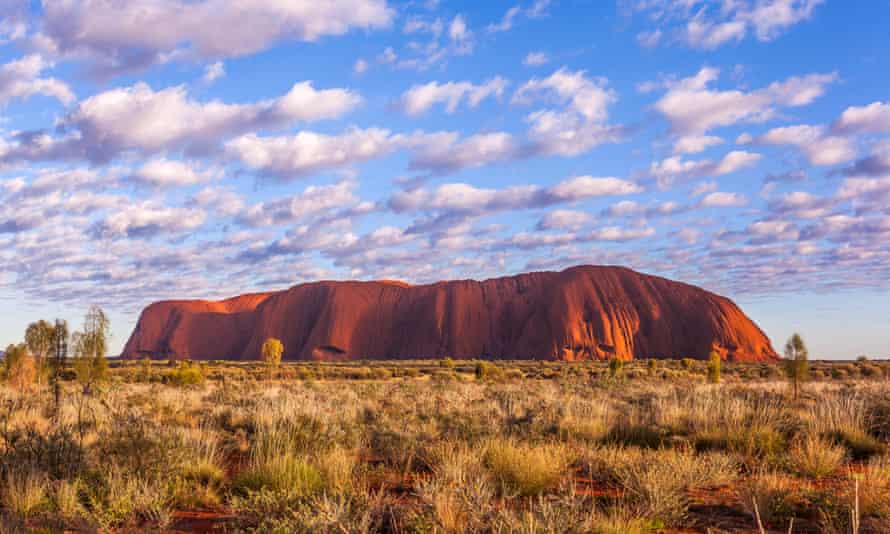Australia’s 20 best travel experiences, ranked by Lonely Planet | Travel
At 7.6m square kilometres, spanning eight climate and three time zones, Australia is a big country. So where do you start?
In making their new book, Lonely Planet’s Ultimate Australia Travel List, the travel guide publisher began by compiling every highlight in their existing books. “We then asked our writers, editors, designers and cartographers in Australia to reveal their favourite spots and experiences,” they say. From there, they solicited votes from a panel of travel experts and members of their community.
The result, “with hundreds of votes cast and a bit of mathematical alchemy, as well as a keen eye on sustainability practices”, is a new book of 500 experiences. They also ended up with “one very clear winner”.
Here is that winner, along with the rest of the book’s Top 20 experiences.
1. Fall silent before the majesty and gravitas of Uluru
Northern Territory/Anangu Country
The landscape of Uluru changes dramatically with the shifting light and seasons. In the afternoon, Uluru appears as an ochre-brown colour, scored and pitted by dark shadows.
As the sun sets, it illuminates the rock in burnished orange, then a series of deeper and darker reds before it fades into charcoal. A performance in reverse, with marginally fewer spectators, is given at dawn.

Uluru is a beautiful, charismatic place. Its dimensions are one thing: it is 3.6km long and rises 348m from the surrounding sands (867m above sea level). If that’s not sufficiently impressive, remember this: two-thirds of the rock lies beneath the sand.
Uluru is a monolith textured with layers of profound spirituality and timeless beauty, the epitome of desert stillness and, in the plays of light and shadow that dance across its surface, one of the richest shows in nature. The sunset viewing areas are once-in-a-lifetime experiences understanding its singular beauty when surrounded by the vast desert around it.
You can also get up close by taking one of the walks that encircle the base. There are many options, but most fold into the Uluru Base Walk, a 10.6km circumnavigation of the rock. Along the way, it passes caves, paintings, sandstone folds and geological abrasions and generally initiates you into the scope and detail of this remarkable place.
Sacred sites are everywhere; entry to and knowledge of the particular significance of these areas is restricted by local law, and knowing this only adds to Uluru’s mystery.
The walk takes you away from the crowds – very few visitors spend long enough here to get to know Uluru this well. There is no better way to experience the rock.
Around 1km from the rock itself, the Uluru-Kata Tjuta Cultural Centre adds depth and perspective to your Uluru experience. Displays and exhibits focus on Tjukurpa (Aboriginal law, religion and custom) and on the natural and human history of the park. Park rangers can supply the informative visitor guide, leaflets and walking notes, as well as other park information.
2. Be confronted and inspired by art at the extraordinary Mona
Tasmania/Palawa Country
Undeniably eccentric, the Museum of Old and New Art (almost universally known as Mona) has ushered Hobart on to the world’s cultural stage.

Opened in 2011, and housed in a Nonda Katsalidis-designed three-storey bunker burrowed into the Triassic sandstone of a peninsula jutting into the Derwent River, Mona is a showcase for founder and owner David Walsh’s remarkable collection of ancient, modern and contemporary art, which is loosely curated under the themes of sex and death.
All cultural roads lead to Mona in January (for Mona Fofa, or Mofo for short) and June (for Dark Mofo) for Tasmania’s largest contemporary music festival.
SEE IT! Mona is 12km north of Hobart’s city centre. The best way to get here is on the museum’s ferry, which departs from Brooke St Pier.
3. Be mesmerised by the Great Barrier Reef
Queensland/Aboriginal and Torres Strait Islander sea country
The Great Barrier Reef isn’t just the world’s largest living organism. Visible from outer space, it’s also one of the planet’s most precious ecosystems – and a gobsmackingly beautiful one to boot.
Home to more than 600 hard and soft coral species and a colourful array of other marine creatures, from tiny nudibranchs (sea slugs) to huge manta rays, this World Heritage-listed area also has cultural significance to more than 70 local Indigenous groups, their connections to the reef dating back some 60,000 years.
It’s no secret, of course, that the Great Barrier Reef faces a number of threats. Yet from coral planting dive trips to Indigenous-led reef tours, there are more opportunities than ever to experience this fragile ecosystem sustainably, helping to ensure that this incredible slice of nature can be enjoyed for generations of…
Read More: Australia’s 20 best travel experiences, ranked by Lonely Planet | Travel

